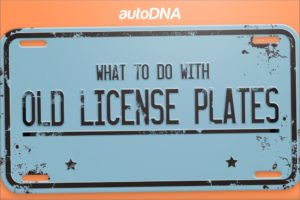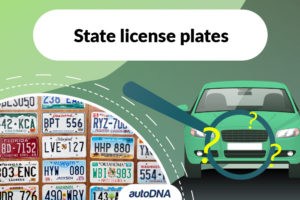
How to Remove License Plate? Check 7 Practical Tips
Table of Contents
Table of Contents
Removing the license plate from your vehicle may seem straightforward, but it’s important to follow the correct steps to avoid damaging your car or the plates themselves. Whether you’re selling your car, switching registration, or simply replacing old plates, here’s a detailed guide to ensure a smooth process.
Step-by-Step Guide: How to Remove License Plate Safely and Efficiently?
Step 1: Gather the Right Tools
Before you begin removing your license plate, it’s essential to have all the necessary tools ready to make the process smooth and hassle-free. Start with a Phillips head or flathead screwdriver, depending on the type of screws securing your plate. Inspect the screws beforehand to determine which type of screwdriver you’ll need to avoid stripping or damaging them.
To protect your hands from dirt, rust, or sharp edges, it’s a good idea to wear gloves, especially if the screws or the plate itself are old or corroded. Additionally, keep a can of lubricant like WD-40 handy, as it can be incredibly useful for loosening screws that are rusty or jammed.
Finally, have a clean cloth nearby to wipe down the area once the plate is removed, ensuring the mounting surface is clean and ready for a new installation. Preparing these tools in advance will save you time and effort, ensuring a seamless plate removal process.
Step 2: Locate the Screws and Brackets
Most license plates are attached to your vehicle with screws located at the top or bottom edges of the plate.
- Examine the plate carefully for any additional brackets, frames, or clips holding it in place.
- Some cars also use plastic holders, which you may need to remove first.
Step 3: Unscrew the License Plate
- Hold the license plate securely with one hand to prevent it from falling once the screws are loosened.
- Use the appropriate screwdriver to turn the screws counterclockwise.
- If screws are stuck due to rust, apply a small amount of lubricant, wait a few minutes, and try again.
- Place the screws in a safe place to avoid losing them, especially if you’ll need them for reinstallation.
Step 4: Check for Additional Fasteners or Clips
Before fully removing the license plate, it’s important to check for any additional fasteners, clips, or brackets that may still be securing it to your vehicle. Some cars, especially newer models or vehicles with custom license plate frames, use extra plastic brackets, adhesive strips, or clips for added stability.
Carefully inspect the edges of the plate and its frame to identify these components. If plastic clips are present, gently press or unclip them by hand, avoiding excessive force to prevent breaking the clips or scratching the surrounding area.
In some cases, plates may also be held in place with adhesive strips or mounting tape, particularly for decorative or temporary frames. To loosen adhesive, apply gentle heat with a hairdryer or heat gun to soften the glue, making it easier to remove the plate without damage.
If zip ties or other fasteners have been used, you may need scissors or pliers to cut them away. Taking the time to thoroughly check for these additional fasteners ensures you can remove the license plate smoothly and prevents unnecessary damage to the plate or mounting area.
Step 5: Clean the Plate Area
Once the plate is removed, clean the surface where it was mounted.
- Use a damp cloth to remove dirt, rust, or adhesive residue.
- If you notice any damage to the mounting area, such as scratches or rust, consider repairing or treating it before installing new plates.
By carefully following these steps, you’ll ensure your license plates are removed without unnecessary hassle, keeping both the plates and your car in excellent condition.
Practical Tips for Easier License Plate Removal
Removing license plates might seem like a simple task, but it’s important to approach the process carefully to avoid damaging your car, the plates, or the screws. Here are some practical tips to help you remove your plates efficiently and safely.
1. Use the Right Tools
Having the proper tools on hand makes a significant difference:
- A Phillips head or flathead screwdriver is essential. Choose the one that matches your screws to avoid stripping them.
- Keep a small can of WD-40 or penetrating oil nearby to loosen rusted license plate screws.
If your screwdriver doesn’t provide enough grip, consider using a power tool with a low-torque setting for more leverage.
2. Protect Yourself and Your Vehicle
- Wear gloves to protect your hands from sharp edges or rust.
- Place a soft cloth or towel under the plate while removing it to prevent scratches to your car’s paint in case the plate falls.
- Ensure your vehicle is parked on a flat surface and engage the parking brake to avoid movement while you work.
3. Deal with Rusted or Stuck Screws
Rusted screws can be frustrating, but they’re manageable with the right approach:
- Spray WD-40 or a similar lubricant on the screws and let it sit for a few minutes before attempting to unscrew them.
- If screws remain stuck, use a screw extractor tool to remove them without damaging the plate or mounting area.
Avoid forcing stuck screws, as this can strip the screw head, making removal even more difficult.
4. Handle Adhesive Stickers with Care
If your license plate has adhesive-backed stickers, removing them can be a hassle:
- Use a hairdryer or heat gun to warm the adhesive, making it easier to peel off.
- Gently lift the edge of the sticker with your fingernail or a plastic scraper. Avoid using metal tools, as they can scratch the plate.
- Clean any remaining residue with rubbing alcohol or adhesive remover for a clean finish.
5. Check for Extra Brackets or Fasteners
Some plates are secured with additional plastic brackets, zip ties, or clips:
- Examine the plate closely before removing screws to ensure all fasteners are accounted for.
- Use a pair of pliers or scissors to cut zip ties if necessary.
- Be gentle when handling plastic brackets to avoid snapping them, especially if you plan to reuse them.
6. Keep the Screws Safe
Once you’ve successfully removed the screws securing your license plate, it’s essential to keep them in a safe and accessible place. These screws are often specific to the mounting area on your vehicle, and losing them could make reinstalling the plate more difficult or costly. Consider placing the screws in a small container, ziplock bag, or even a magnetic tray to ensure they don’t roll away or get misplaced.
If you’re planning to install new license plate, having the original screws on hand will save time and ensure a proper fit. Additionally, inspect the screws for signs of wear, rust, or damage before reusing them. If they appear corroded or stripped, it’s a good idea to replace them with new screws of the same size and type to avoid future issues during reinstallation. Taking a few extra moments to secure the screws will save you the hassle of searching for replacements later.
7. Clean the Plate and Mounting Area
After removal, take a moment to clean both the plate and the mounting surface on your vehicle:
- Wipe away dirt, grime, or adhesive residue with a damp cloth.
- If there’s any rust or damage on the mounting area, treat it with rust remover or touch-up paint to prevent further corrosion.
By applying these practical tips, you’ll save time and effort while ensuring a smooth, hassle-free experience when removing your license plates.
Safely Remove the License Plate and Install New License Plates
When handling the front plate, you may encounter challenges such as rusted bolts or tight screws, especially if the vehicle has been exposed to harsh weather. In such cases, using a flat head screwdriver in combination with a penetrating oil like WD-40 can make the removal process significantly easier.
Apply the oil to the bolts and let it sit for a few minutes to loosen the rust and grime. Once the old plate is removed, inspect the area near the mounting holes and around components like the backup lights, ensuring there’s no residue or damage that could interfere with the installation of your new plate. Cleaning and preparing the surface properly will help secure the new plate firmly, ensuring it stays in place and looks professional. Attention to detail at every step will save time and avoid potential issues during reinstallation.
To ensure the plate installed is secure and aligned correctly, use the appropriate screw driver to tighten the screws evenly, avoiding over-tightening which could damage the mounting area or the plate itself.
In summary, removing a license plate is a straightforward task when approached with the right tools and preparation. Whether you’re preparing to trade in your vehicle or install a new license plate on a new car, ensuring the process is done carefully prevents unnecessary damage. Most plates are secured with two screws, but if you encounter rusted bolts, applying Liquid Wrench can help loosen them.
Use a screw driver or, if the bolts have a hex head, a wrench or socket tool for better grip. Once the bolt free condition is achieved, inspect the mounting area for damage or residue. If the old bolts are unusable, replace them with new bolts to ensure the plate is securely attached. Should a thing happened like stripping the bolts, take extra care not to damage the car’s mounting holes. With proper attention, your new plates will be firmly in place and ready for the road.
At autoDNA.com, the market-leading VIN decoding tool, you can free VIN lookup on a given vehicle. All you need for this is the VIN number. In the reports, on used cars, you can find information that will allow you to check whether the seller is telling the truth or not. In the report, you can find data on various topics. One of them is the vehicle history or stolen vehicle bases. You can do a VIN check for free 24/7 throughout the year.
How to remove my license plates?
The process is the same for personal plates. Remember to handle the plates carefully to avoid bending them. If you’re transferring the plates to a new vehicle, ensure they remain in good condition.
How to remove stickers from license plates?
To remove stickers from license plates, start by using a hairdryer or heat gun to gently warm the sticker, which will soften the adhesive and make it easier to peel off. Once heated, use your fingernail or a plastic scraper to lift the edge of the sticker and slowly peel it away. If any residue remains, apply rubbing alcohol or adhesive remover to the area and wipe it clean with a cloth. Avoid using sharp metal tools, as they can scratch the plate's surface. After the plate is clean, ensure it is dry and free of debris before reusing or installing it.











